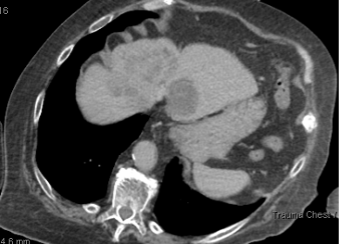Sunday Poster Session
Category: Liver
P1817 - When Diarrhea Isn’t Just Diarrhea: A Case of Metastatic pNET with Hemodynamic Collapse
Sunday, October 26, 2025
3:30 PM - 7:00 PM PDT
Location: Exhibit Hall
- SB
Sakshi Bai, MD
Henry Ford Jackson Hospital
Jackson, MI
Presenting Author(s)
Sakshi Bai, MD1, Muhammad R. Malik, MD1, Bipneet Singh, MD1, Fnu Sagar, MD2, Fnu Sanjna, MBBS3, FNU Payal, MD4
1Henry Ford Jackson Hospital, Jackson, MI; 2Jinnah Sindh Medical University, Jackson, MI; 3Ghulam Muhammad Mahar Medical college, Jackson, MI; 4Monmouth Medical Center, Robert Wood Johnson Medical School of Rutgers University, Long Branch, NJ
Introduction: Pancreatic neuroendocrine tumors (pNETs) are rare malignancies, comprising less than 2% of all pancreatic neoplasms. When functional, they can produce a wide range of hormonal symptoms. However, non-functional pNETs often evade early detection, presenting only after extensive metastasis. We present a rare case of a metastatic pNET manifesting with severe diarrhea, hypotension, and multiorgan dysfunction—mimicking sepsis and gastrointestinal bleeding.
Case Description/
Methods: A 71-year-old male with a background of coronary artery disease, heart failure (EF 65%), COPD, and ICD presented with progressive bilateral leg weakness, lethargy, and multiple episodes of bloody diarrhea. On admission, he was hypotensive (BP 81/71 mmHg), jaundiced, and in atrial flutter. Labs revealed leukocytosis, acute kidney injury, cholestatic liver pattern, and progressive thrombocytopenia. CT abdomen/pelvis showed multiple hepatic lesions concerning for metastasis. Tumor markers were notable for CA 19-9 of 421.6 U/mL and chromogranin A of 808 ng/mL. CEA and AFP were within normal limits. Stool studies, including C. difficile toxin, were negative. Due to persistent instability, endoscopic evaluation and biopsy were deferred. Clinical suspicion of a neuroendocrine tumor was made based on biomarker profile and imaging. Despite aggressive supportive measures, the patient developed multiorgan failure. He opted for comfort-focused care and passed away shortly after ICU transfer.
Discussion: This case underscores the importance of considering NETs in patients with unexplained secretory diarrhea, liver lesions, and systemic deterioration. pNETs can remain clinically silent until advanced stages and may mimic more common pathologies like gastrointestinal bleeding or sepsis. Biomarkers such as chromogranin A can guide diagnosis when invasive procedures are contraindicated. Early recognition is essential to improve outcomes, though in advanced cases, therapeutic options may be limited.

Figure: CT scan showing liver metastasis
Disclosures:
Sakshi Bai indicated no relevant financial relationships.
Muhammad Malik indicated no relevant financial relationships.
Bipneet Singh indicated no relevant financial relationships.
Fnu Sagar indicated no relevant financial relationships.
Fnu Sanjna indicated no relevant financial relationships.
FNU Payal indicated no relevant financial relationships.
Sakshi Bai, MD1, Muhammad R. Malik, MD1, Bipneet Singh, MD1, Fnu Sagar, MD2, Fnu Sanjna, MBBS3, FNU Payal, MD4. P1817 - When Diarrhea Isn’t Just Diarrhea: A Case of Metastatic pNET with Hemodynamic Collapse, ACG 2025 Annual Scientific Meeting Abstracts. Phoenix, AZ: American College of Gastroenterology.
1Henry Ford Jackson Hospital, Jackson, MI; 2Jinnah Sindh Medical University, Jackson, MI; 3Ghulam Muhammad Mahar Medical college, Jackson, MI; 4Monmouth Medical Center, Robert Wood Johnson Medical School of Rutgers University, Long Branch, NJ
Introduction: Pancreatic neuroendocrine tumors (pNETs) are rare malignancies, comprising less than 2% of all pancreatic neoplasms. When functional, they can produce a wide range of hormonal symptoms. However, non-functional pNETs often evade early detection, presenting only after extensive metastasis. We present a rare case of a metastatic pNET manifesting with severe diarrhea, hypotension, and multiorgan dysfunction—mimicking sepsis and gastrointestinal bleeding.
Case Description/
Methods: A 71-year-old male with a background of coronary artery disease, heart failure (EF 65%), COPD, and ICD presented with progressive bilateral leg weakness, lethargy, and multiple episodes of bloody diarrhea. On admission, he was hypotensive (BP 81/71 mmHg), jaundiced, and in atrial flutter. Labs revealed leukocytosis, acute kidney injury, cholestatic liver pattern, and progressive thrombocytopenia. CT abdomen/pelvis showed multiple hepatic lesions concerning for metastasis. Tumor markers were notable for CA 19-9 of 421.6 U/mL and chromogranin A of 808 ng/mL. CEA and AFP were within normal limits. Stool studies, including C. difficile toxin, were negative. Due to persistent instability, endoscopic evaluation and biopsy were deferred. Clinical suspicion of a neuroendocrine tumor was made based on biomarker profile and imaging. Despite aggressive supportive measures, the patient developed multiorgan failure. He opted for comfort-focused care and passed away shortly after ICU transfer.
Discussion: This case underscores the importance of considering NETs in patients with unexplained secretory diarrhea, liver lesions, and systemic deterioration. pNETs can remain clinically silent until advanced stages and may mimic more common pathologies like gastrointestinal bleeding or sepsis. Biomarkers such as chromogranin A can guide diagnosis when invasive procedures are contraindicated. Early recognition is essential to improve outcomes, though in advanced cases, therapeutic options may be limited.

Figure: CT scan showing liver metastasis
Disclosures:
Sakshi Bai indicated no relevant financial relationships.
Muhammad Malik indicated no relevant financial relationships.
Bipneet Singh indicated no relevant financial relationships.
Fnu Sagar indicated no relevant financial relationships.
Fnu Sanjna indicated no relevant financial relationships.
FNU Payal indicated no relevant financial relationships.
Sakshi Bai, MD1, Muhammad R. Malik, MD1, Bipneet Singh, MD1, Fnu Sagar, MD2, Fnu Sanjna, MBBS3, FNU Payal, MD4. P1817 - When Diarrhea Isn’t Just Diarrhea: A Case of Metastatic pNET with Hemodynamic Collapse, ACG 2025 Annual Scientific Meeting Abstracts. Phoenix, AZ: American College of Gastroenterology.
